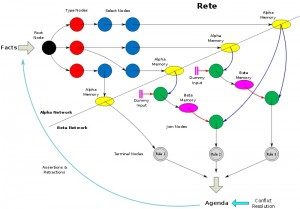At the heart of cognitive information process is the production rule, the procedural tool which builds propositions which are then connected in production systems and connectionist models of various types to generate new propositions from long term memory. Here is a simple production rule with two propositions:
Example IF (Score >49) THEN (Mark =”PASS”)
This reads as “If a score is greater then 49 it is a pass”. Phrased in the Prolog computer language the same propositions would be rendered as SCORE [>49, PASS]. Continuing along in the same vein, SON [MALE CHILD, FATHER/MOTHER], would be read as… got it…? Yes, “A son is the male child of a father or mother”.
Let’s see if you can apply this knowledge. Read this: MORTIMER[ SON,”HORTENSE”]… It is so simple!, right? Add another rule, say, MORTIMER [SON,”GORDON CAMPBELL”] and suddenly you can generate a logical inference “Mortimer is the son of Hortense and Gordon Campbell. To give you sense of how massive such a production system can get when the computer itself starts generating logical inferences, the goal of the Japanese Fifth Generation Computer Project was to develop a system that could do over 1,000, 000 logical inferences per second (LIPS). That was in the mid-1980s. We have no idea how many LIPS Watson could manage, but it must have been an astonishingly high number.
The Mortimer example reveals a major challenge to the production system paradigm. It cannot tell a lie, from a fact that is. A bad person could simply replace his or her name with poor Mortimer and change him into an orphan. There goes the family inheritance!
Nonetheless, production systems and the connected models it can generate remain the principle drivers of cognitive information processing research. One such engine is the Rete (Latin for “net”) Algorithm for fact-checking working memory, something most production systems do to prevent the kind of abuse described above. Here is what the basic model looks like, just so you know. If you want to know more look it up in Wikipedia.
So, let’s see if you can think of some other challenges facing the Rete in distinguishing fact from factoid. In our course readings Professor Schunk acknowledges the problems of motivation and of knowing when to stop activating memory (pp 165-167). What could he possibly be talking about? What would you ask him if he were looking you right in the eye? Well, here he is!


